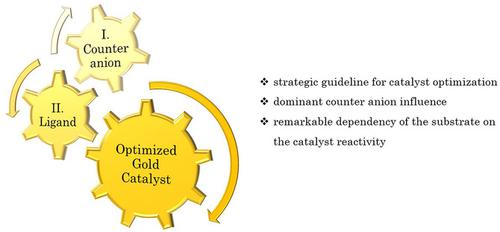An Industrial Perspective on Counter Anions in Gold Catalysis: Underestimated with Respect to “Ligand Effects”
Jasmin Schießl; Jürgen Schulmeister; Angelino Doppiu; Eileen Wörner; Matthias Rudolph; Ralf Karch; A. Stephen K. Hashmi
文献索引:10.1002/adsc.201800233
全文:HTML全文
摘要

The conversion of a variety of well‐known test reactions, representing the key reactivity patterns of gold catalysis, were analyzed by GC and 1H NMR. The study is focused on establishing of a strategical approach for the consideration of ligand influence and counter anion influence during the catalyst optimization including an industrial perspective. The study shows a dominance of the counter anion, a dominance which up to now has been neglected in most of the routine screenings. In addition, a drastic substrate‐dependency became obvious, even a marginal variation of the substrate already could strongly effect the catalytic activity and change the optimal counter anion or ligand. Based on the collected data a strategic concept for an efficient screening for a specific substrate is introduced, this concept can serve as an important guideline for catalyst optimization in homogeneous gold catalysis.
|
Iridium‐Catalyzed Tandem Cyclization of Benzoylacetonitriles...
2018-04-19 [10.1002/adsc.201800149] |
|
Aluminium Chloride‐Mediated Synthesis of 1‐Chloro‐2,2,2‐Trif...
2018-04-19 [10.1002/adsc.201800275] |
|
DBU‐Catalyzed [3+3] and [3+2] Annulation Reactions of Azomet...
2018-04-18 [10.1002/adsc.201800030] |
|
One‐pot Construction of Difluorinated Pyrrolizidine and Indo...
2018-04-18 [10.1002/adsc.201701643] |
|
Rhodium‐Catalyzed Chemo‐ and Enantioselective Hydrogenation ...
2018-04-17 [10.1002/adsc.201800243] |